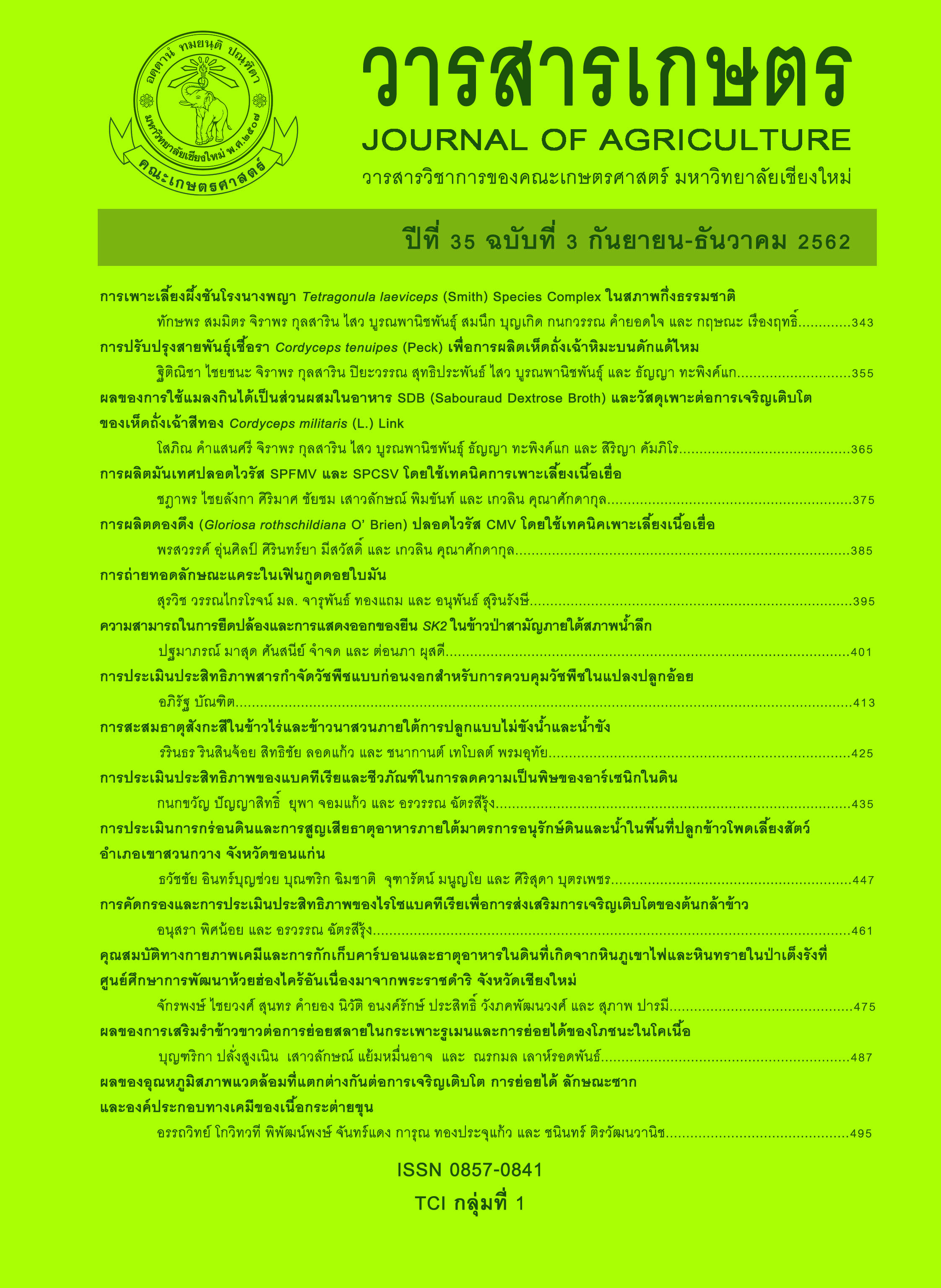Evaluation of Preemergence Herbicide Efficacy for Weed Control in Sugarcane Field
Main Article Content
Abstract
Weed is the major factor influencing sugarcane yield loss in a competitive situation between the crop and weed. The most common method of weed control in sugarcane field has been conducted by herbicides. A field study was evaluated the efficacy of preemergence herbicide (diclosulam, diuron / hexazinone, indaziflam, imazapic + pendimethalin and sulfentrazone) application in sugarcane field as for a single row and double row. The results showed that the application of diuron / hexazinone at 210.6 + 59.4 g a.i./rai, indaziflam at 8 g a.i./rai, imazapic + pendimethalin at 12 + 148.5 g a.i./rai and sulfentrazone at 76.8 g a.i./rai controlled total weeds as in the similar level and it was not affected on crop growth under different planting methods. An exception was found in of diclosulam at 8.4 g a.i./rai which has the lowest level of total weed control when compared with the other herbicides. However, the highest level of broad spectrum activity was obtained with diuron / hexazinone and indaziflam. The indaziflam can provide a level of broad spectrum activity at low application rate than diuron / hexazinone. Therefore, indaziflam could provide a new alternative herbicide use in the sugarcane field.
Article Details
References
Cane and Sugar Promotion Center Region 2. 2017. Details of the data collection process in field. (Online). Available: http://kampangpetch.csrcenter.org/?page_id=249 (December 25, 2017). (in Thai)
El-Nahhal, Y. and N. Hamdona. 2017. Adsorption, leaching and phytotoxicity of some herbicides as single and mixtures to some crops. Journal of the Association of Arab Universities for Basic and Applied Sciences 22(1): 17-25.
González-Delgado, A.M., M.K. Shukla, J. Ashigh and R. Perkins. 2017. Effect of application rate and irrigation on the movement and dissipation of indaziflam. Journal of Environmental Sciences 51: 111-119.
Heap, I. 2018. The international survey of herbicide resistant weeds. (Online). Available: http://www.weedscience.org (June 10, 2018).
Obien, S.R. and A.M. Baltazar. 1979. Weed control in sugarcane in the Philippines. pp. 45-55. In: Proceedings of the 9th Pest Control Council of the Philippines Conference, Manila.
Office of Agricultural Research and Development Region 5. 2018. Knowledge management; the technology of sugarcane production in the central and western regions. (Online). Available: http://www.sugarzone.in.th/cane/cane_know.pdf (October 30, 2018). (in Thai)
R Development Core Team. 2009. R: a language and environment for statistical computing, (Online). Available: https://cran-archive.r-project.org/bin/windows/base/old/2.9.1/ (February 10, 2015).
Ramburan, S. and N. Nxumalo. 2017. Regional, seasonal, cultivar and crop-year effects on sugarcane responses to residue mulching. Field Crops Research 210: 136-146.
Sebastian, D.J., S.J. Nissen, P. Westra, D.L. Shaner and G. Butters. 2017. Influence of soil properties and soil moisture on the efficacy of indaziflam and flumioxazin on Kochia scoparia L. Pest Management Science 73(2): 444-451.
Vanhala, P., D. Kurstjens, J. Ascard, A. Bertram, D.C. Cloutier, A. Mead, M. Raffaelli and J. Rasmussen. 2004. Guidelines for physical weed control research: flame weeding, weed harrowing and intra-row cultivation. pp. 208-239. In: Proceedings of the 6th EWRS Workshop on Physical and Cultural Weed Control, Lillehammer.
Vera, C.L., S.M. Woods and J.P. Raney. 2006. Seeding rate and row spacing effect on weed competition, yield and quality of hemp in the Parkland region of Saskatchewan. Canadian Journal of Plant Science 86(3): 911-915.
Yirefu, F., T. Tana, A. Tafesse and Y. Zekarias. 2012. Competitive ability of sugarcane (Saccharum officinarum L.) cultivars to weed interference in sugarcane plantations of Ethiopia. Crop Protection 32: 138-143.
Yirefu, F., T. Tana, A. Tafesse and Y. Zekarias. 2013. Weed interference in the sugarcane (Saccharum officinarum L.) plantations of Ethiopia. Agriculture, Forestry and Fisheries 2(6): 239-247.
Zafar, M., A. Tanveer, Z.A. Cheema and M. Ashraf. 2010. Weed-crop competition effects on growth and yield of sugarcane planted using two methods. Pakistan Journal of Botany 42(2): 815-823.


